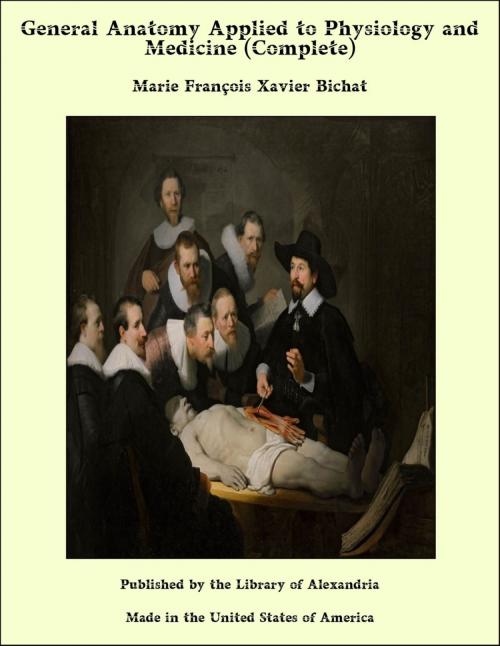General Anatomy Applied to Physiology and Medicine (Complete)
Nonfiction, Religion & Spirituality, New Age, History, Fiction & Literature| Author: | Marie François Xavier Bichat | ISBN: | 9781465618122 |
| Publisher: | Library of Alexandria | Publication: | March 8, 2015 |
| Imprint: | Language: | English |
| Author: | Marie François Xavier Bichat |
| ISBN: | 9781465618122 |
| Publisher: | Library of Alexandria |
| Publication: | March 8, 2015 |
| Imprint: | |
| Language: | English |
In the other parts of the body, the sub-cutaneous cellular texture varies considerably. 1st. The density of this texture is remarkable in the hairy scalp, which is with difficulty separated on that account from the aponeuroses and subjacent muscles. Those who have often examined patients who have died of apoplexy, know that sometimes their heads and necks are emphysematous; I have already seen four. Now whilst considerable air is found in the face, little or none is met with under the hairy scalp. 2d. In the face, the sub-cutaneous texture is remarkably loose, it is very abundant there. 3d. Upon the trunk this laxity is also very evident; it accommodates itself to the motions which the great and broad muscles perform there. 4th. Upon the extremities, the sub-cutaneous cellular texture, situated between the aponeuroses and the skin, offers almost every where an equal degree of relaxation. It is only upon the palm of the hand and the sole of the foot that, its texture becoming more compact, the adhesion of the aponeuroses to the skin is more evident, an arrangement that is favourable to the use of these two parts, which are designed to adapt themselves to the forms of external bodies, to grasp and hold them. It is to this compact texture, that must be referred the difficulty that exists of making these parts subject to dropsical effusions. Long after every other part of the sub-cutaneous texture is infiltrated, this preserves its ordinary state. I have seen two patients affected with elephantiasis, where every part of the skin and subjacent texture of the lower extremities was enormously swelled, except the sole of the foot. The contrast of this part, remaining in its natural state, with the top of the foot, which was raised to an enormous swelling, gave that peculiar appearance that all authors have noticed. At the place of the annular ligaments, the sub-cutaneous cellular texture is very compact, and the adhesion of the skin, is also very evident; hence those contractions that are seen in the limbs of infants at the place of the ligaments, the fat penetrating but very little into the cells, that are very closely drawn together. The sub-cutaneous cellular texture has several different uses. It furnishes the skin with the great mobility it enjoys, a mobility that is particularly observable in the great motions of the trunk and extremities, in the collisions it experiences with external bodies, in the different tumours that get to a great size, as in sarcocele, which is often covered at the expense of a part of the integuments of the penis, the abdomen and the thigh, which are stretched and have a real locomotion.
In the other parts of the body, the sub-cutaneous cellular texture varies considerably. 1st. The density of this texture is remarkable in the hairy scalp, which is with difficulty separated on that account from the aponeuroses and subjacent muscles. Those who have often examined patients who have died of apoplexy, know that sometimes their heads and necks are emphysematous; I have already seen four. Now whilst considerable air is found in the face, little or none is met with under the hairy scalp. 2d. In the face, the sub-cutaneous texture is remarkably loose, it is very abundant there. 3d. Upon the trunk this laxity is also very evident; it accommodates itself to the motions which the great and broad muscles perform there. 4th. Upon the extremities, the sub-cutaneous cellular texture, situated between the aponeuroses and the skin, offers almost every where an equal degree of relaxation. It is only upon the palm of the hand and the sole of the foot that, its texture becoming more compact, the adhesion of the aponeuroses to the skin is more evident, an arrangement that is favourable to the use of these two parts, which are designed to adapt themselves to the forms of external bodies, to grasp and hold them. It is to this compact texture, that must be referred the difficulty that exists of making these parts subject to dropsical effusions. Long after every other part of the sub-cutaneous texture is infiltrated, this preserves its ordinary state. I have seen two patients affected with elephantiasis, where every part of the skin and subjacent texture of the lower extremities was enormously swelled, except the sole of the foot. The contrast of this part, remaining in its natural state, with the top of the foot, which was raised to an enormous swelling, gave that peculiar appearance that all authors have noticed. At the place of the annular ligaments, the sub-cutaneous cellular texture is very compact, and the adhesion of the skin, is also very evident; hence those contractions that are seen in the limbs of infants at the place of the ligaments, the fat penetrating but very little into the cells, that are very closely drawn together. The sub-cutaneous cellular texture has several different uses. It furnishes the skin with the great mobility it enjoys, a mobility that is particularly observable in the great motions of the trunk and extremities, in the collisions it experiences with external bodies, in the different tumours that get to a great size, as in sarcocele, which is often covered at the expense of a part of the integuments of the penis, the abdomen and the thigh, which are stretched and have a real locomotion.















